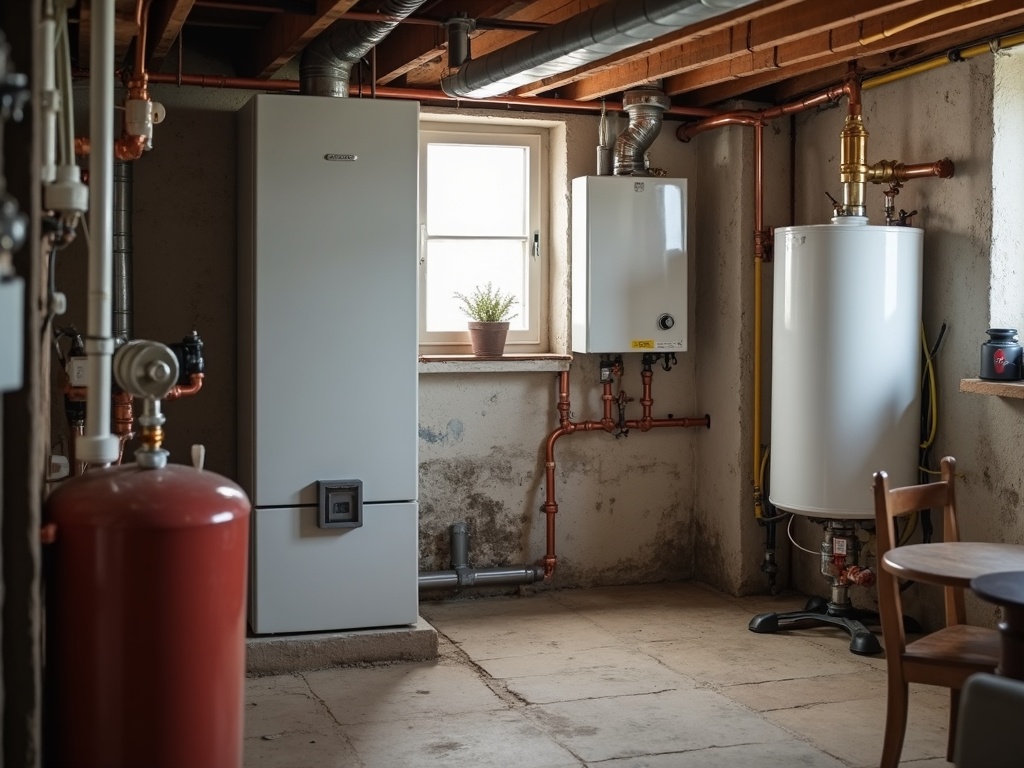Your heating system won’t normally just quit working overnight. It will typically go through a process of declining efficiency over several months or years before eventually failing entirely. However, once it fails, the repairs are likely to cost you a lot more than they would have had you taken care of some of the issues when they were smaller.
Why You Won’t See Things Going Wrong Until It’s Too Late
Most heating systems are designed to continue operating despite failing or worn-out parts. Your boiler will produce hot water even if the heat exchanger has many small cracks. Your burner will light even if the flame sensor is partially clogged. As such, your heating system continues to function, often for years, while silently developing major problems.
The Subtle Slide into Failure No One Sees Coming
The majority of heating system problems develop slowly and silently over time. This is due to a gradual loss of efficiency in the operation of the heating system. At the beginning of a heating system’s life, it operates at full capacity as intended. However, as time passes, sediment and debris build up on the heat exchanger surfaces, and the burner parts begin to wear out. In addition, air filter efficiency is compromised over time, and although they may appear clean after being cleaned, the filters never seem to return to 100 percent airflow again.
In isolation, each of these factors will not immediately cause significant problems, and you will generally not notice that your heating system is functioning at 98 percent efficiency compared to 100 percent a few years back. However, over time, if these types of inefficiencies continue to occur, your heating system will be operating at around 75 percent of its original efficiency. Although your energy costs may increase slightly, you will not see a sudden jump in your costs, and therefore, you will likely not notice that anything is amiss.
However, the problem is that the inefficiencies caused by these problems force your heating system to operate harder to achieve the same level of warmth as previously achieved. This increased workload causes additional wear and tear on the remaining healthy components of the heating system. Therefore, you are experiencing this cascade effect of a series of interrelated problems, none of which are individually catastrophic. Instead, you are experiencing a series of problems that are collectively catastrophic.
Safety Risks That Are Difficult to Identify
There are also cases where the deterioration of a heating system can lead to safety-related concerns. For example, carbon monoxide (CO) poisoning is not a risk that is announced with flashing warning signs. A crack in a heat exchanger may initially allow for only minimal amounts of CO to escape into your home. The heating system will continue to provide heat to your home.
As the heat exchanger continues to be used, however, the crack will continue to grow, and the amount of CO escaping will increase over time. Most homeowners will not recognize the risk of CO exposure until either a CO detector alerts them to the danger or a service technician discovers the heat exchanger crack during a routine inspection.
Similar to the heat exchanger failure described above, improper combustion in a heating system can lead to a variety of problems. If combustion is not occurring correctly within a heating system due to problems associated with dirty or improperly aligned components, you may experience incomplete combustion. Since the system is producing heat, you will believe everything is functioning as expected.
However, you may be introducing particulate matter (soot), burning fuel inefficiently, and adding unnecessary stress to other components in the heating system. Larger or more complex heating systems require specialized commercial service technicians, like those who specialize in Commercial Burner Service Canberra, to perform the required maintenance and avoid the potential consequences of improper combustion.
The Difficulty in Identifying Silent Problems
Unfortunately, the difficulty lies in recognizing that these types of problems exist. Homeowners rarely take proactive steps to address minor problems, as they may not seem severe at the moment. Unfortunately, as stated earlier, the problems with heating systems are progressive in nature, and by the time homeowners finally acknowledge the need for service, they have developed into far more serious and costly problems than they would have if addressed earlier.
Components That Will Fail Silently
While most heating system components make some type of noise when they fail, certain components will fail without producing any audible alarm. Examples include pumps, thermostats, and expansion vessels.
Pump Failure
A pump in a heating system loses efficiency as the bearings wear out and/or the impeller corrodes. The pump is able to circulate water through the radiators or under floor heating elements, so the homeowner remains warm. However, the pump must work harder to create the same volume of circulation as before, and consequently, it uses more electricity and generates more heat in the pump housing.
Thermostat Drift
Thermostats can also “drift” out of calibration. If the thermostat believes the house is at 21°C when it is actually at 19°C, the system will continue to operate for longer periods of time to try and reach a temperature that the thermostat believes exists.
This occurs slowly enough that most people simply believe that their house is colder than it should be and adjust the thermostat up rather than suspecting that the thermostat itself may be malfunctioning.
Expansion Vessel Failure
Expansion vessels are another silent failure waiting to happen. Expansion vessels are responsible for maintaining the correct pressure levels in closed-loop heating systems. When the expansion vessel fails, the pressure in the system becomes unstable and begins to oscillate wildly. The system will still function but will cycle on and off more frequently, which further exacerbates the failure of other components.
By the time the homeowner notices that the pressure gauge is fluctuating wildly, the expansion vessel has probably been damaged for months.
How One Failing Component Creates a Cascade of Problems
One of the biggest dangers of gradual degradation is how one failing component can create a cascade of problems for other components. When a pump fails, it reduces the flow rate of the entire system. This results in the boiler heat exchanger not cooling properly, and thus the boiler is forced to run hotter than designed. Running at a higher temperature increases the formation of scales and the fatigue of metals, causing a cycle of problems.
Or, for example, when filters become clogged, it restricts airflow through the system and prevents effective dissipation of heat. This triggers safety cut-offs more frequently. The system shut-downs and restarts repeatedly, and each time it restarts creates a small shockwave of stress on the electrical components and control board.
These cascading failures are expensive because, by the time you call someone to come out and fix the problem, you’re not fixing one thing; you’re replacing several components that have been affected by the same underlying problem that was ignored for too long. What could have been a simple cleaning or adjustment six months ago is now a multi-part replacement job.
How to Catch These Problems Early
The unfortunate truth is that the only way to catch gradual deterioration is to actively seek it out. Regular servicing can help identify gradual deterioration; however, the quality of the servicing is dependent upon the quality of the technician performing the servicing. A cursory examination of your heating system and testing of a single firing sequence will not reveal most of the problems discussed in this article.
To detect gradual deterioration, you need to perform a systematic examination of the components of your heating system that are prone to gradual deterioration. This includes measuring combustion efficiency as opposed to merely verifying that the system fires. Measuring water flow rates and pressures during operation. Testing safety cut-off points to verify that they are tripping at the appropriate threshold. Examining the electrical draw of the motor(s) to determine if they are consuming excessive power.
Unless you have the knowledge and equipment necessary to perform these examinations, you cannot reasonably expect to perform them yourself. However, understanding that gradual deterioration exists, and that “it still works” does not equate to “it works well,” will assist in rationalizing the expense of regular maintenance. You are not merely paying to confirm that your heating system functions. You are paying for the technician to identify problems prior to them announcing themselves in an expensive manner. There is a distinction between those two statements, even though they appear to be identical from the exterior.




